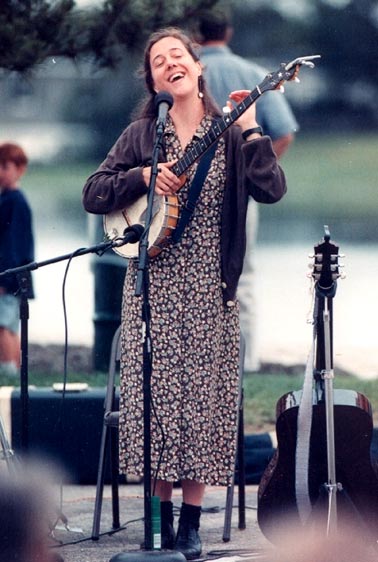
02 Jul If You Want To Sing Out, Sing Out with Aubrey Atwater
 Using clogging, music and storytelling to charm Folk School audiences since 1996, Aubrey exudes a talent, grace, and humor unique to only the most tenured and talented of performers. Aubrey returns to the Folk School this September to teach two dynamite classes: Singing with Clawhammer Banjo (Sept. 8-13) and Clogging (Sept. 13-15 – Weekend). She is also scheduled to perform in special Thursday night concert, Sept. 12, 7 p.m. Don’t miss out on this opportunity to learn to play, laugh, sing, and dance with Aubrey this fall!
Using clogging, music and storytelling to charm Folk School audiences since 1996, Aubrey exudes a talent, grace, and humor unique to only the most tenured and talented of performers. Aubrey returns to the Folk School this September to teach two dynamite classes: Singing with Clawhammer Banjo (Sept. 8-13) and Clogging (Sept. 13-15 – Weekend). She is also scheduled to perform in special Thursday night concert, Sept. 12, 7 p.m. Don’t miss out on this opportunity to learn to play, laugh, sing, and dance with Aubrey this fall!
I recently checked in with Aubrey to talk to her about her upcoming classes, the Folk School, tunes, heroes, dance moves, folk music, the Phoebe, and more! Here’s what we talked about:
CP: You teach quite regularly at the Folk School. How did you find the Folk School? When did you teach your first class?
AA: I got the idea to apply to the folk school in the mid-90s when I saw that one of my dulcimer player mentors, Lorraine Hammond, from Boston, was working there. I got in touch, sent materials, and was invited to teach my first class in 1996. I thought I had died and gone to heaven-what a unique, beautiful, nurturing, and exciting place! Teaching a 30+ hour dulcimer class felt daunting back then for my younger self. I was nearly quivering on the plane as I travelled to the Folk School. I have learned a lot over the years teaching at the Folk School. The luxury of time in the week-long class has been a great opportunity to refine and expand my teaching.
CP: Do you think anyone can learn to sing? Do you have to know how sing well to take your classes?
AA: YES to first question – I think anyone can learn to sing. Absolutely NO to second question – you do not need to know how to sing well to take my classes. This question reminds me of college when I took a few drawing classes at the Rhode Island School of Design. I realized that maybe I didn’t have a deeply inherent gift, but I learned the skill quite well. Some people can easily SING and it is beautiful, like when they are three years old. Some people don’t have the gift quite as well, but I have never ever denied someone who wanted to sing or learn to control the pitch of their voice better. I think of two students in particular over the years who considered themselves “tone deaf” and we worked together, trained, and over time, I heard each of them sing on pitch. There were tears. It was quite a moment, very moving!
CP: What came first for you, playing music or dancing? How did you learn clawhammer banjo? How did you learn to clog?
AA: I started playing piano by ear at about 5 years old, then my parents started me on piano lessons. I quit at 13 and then picked up the guitar at age 15. I had a defining moment that summer in 1979. I figured out how to play two simple chords to a Beatles song and then I sang along and voila! I could play a song and then I was off and running and have never looked back. It was a major turning point in my life.
From there I learned to play the tin whistle, mountain dulcimer and in my late 20’s, I went to Eastern Kentucky and started to learn clawhammer banjo and to dance. My friend Cari Norris taught me. She is the granddaughter of the legendary Lily May Ledford, leader of the first all-female string band, The Coon Creek Girls, in the early radio days, so I got to learn from a wonderful lineage of women. When I wasn’t with Cari in Kentucky, I’d commission her to send instructional recordings (cassettes!), and she walked me through tunes by ear that way. That same time frame, I learned a few clogging steps (aka Flatfooting) and then over time, I learned traditional freestyle clogging by imitating and collecting steps from percussive dancers I would meet on the road. It was a wondrous and quite traditional way to learn. More than ten years later, somewhere in my 40’s, I said to my husband Elwood, with some surprise, “I’m a dancer!” I had never taken dance as a child.
CP: Do you have a favorite tune right now?
AA: Yes, always. It is often whatever song I am learning at the moment. I am always having some kind of a love affair with a song. Two right now are: “The Jamestown Homeward Bound,” a 19th century seafaring song and “Mornin’s Come, Mariah’s Gone,” a Jean Ritchie song. Another song I have sung to myself all year is the beautiful hymn “Resignation” written in 1719 by Isaac Watts.
Pete Seeger is famous for saying a song can change the world and I believe that songs help heal our broken hearts. My father died last year and we lost a bunch of other old friends and family members nearly all at once. That one quiet and beautiful song has rescued me over and over again in the last year.
CP: As a musician who has performed multiple times at the Folk School, do you have a tune you always include in your set? How many times have you performed at the Folk School?
AA: I have performed at the Folk School about every year since 1996. It is one of my absolute utter favorite places in the world to play, teach and visit. When I am on that stage and looking at that roomful of smiling, warm, and, now, many familiar faces, I am in one of my happiest places. I often, but not always, play “The Devil and the Farmer’s Wife” at the end of my shows. It’s a silly, centuries-old song about the devil who comes up from Hell to talk to a dimwitted farmer about taking one of his family members back with him. The farmer says, “Don’t take my son, I need him on the farm. But you can have my wife.” Then we see how things turn out for the DEVIL. It’s a very funny song, still, to this day! Someone captured in on video last time I was there:
CP: Who are your dance/music heroes?
AA: Lots of people but Jean Ritchie is number one in terms of my greatest source and inspiration for traditional American folk songs. She is 90 and we’ve known each other for 21 years. She appeared publicly until she was 87. She has had a fascinating, remarkable career and is an amazing woman, role model, icon, friend, mentor. I teach workshops on Ritchie Family songs and often ask participants if they can think of another famous female folk singer from her generation and we are often hard pressed to do so. Her late husband George was a wonderful man, filmmaker, photographer and they had a unique and beautiful partnership. Married for 60 years, he supported Jean every step of the way. I have many other heroes and role models. Pete Seeger and Joni Mitchell spring to mind immediately as well. I could go on and on about the steadfast genius, bravery, and inspiration of these folks….
CP: When you play music, do you enjoy playing a concert, a dance, a jam, with your hubbie, or by yourself the most?
AA: Hmm, good question. I think I like doing the concerts with Elwood the MOST although I like all of the above. Being together performing concerts feeds me like nothing else. The entertainment world we dwell in is so sweet, so kind. Some of the nicest people in the world come to our shows. The exchange of energy I feel when I am on one of our small stages, looking at the faces of our audience, is so lovely. Our audiences are fairly small, not often more than 50-200 people and we often get to talk with people before, in the middle, afterwards. We have made many, many friends over the years, and heard many stories. It is a way in which I feel we have our finger on the pulse of humanity, especially aspects of American society. Our concerts is one of the arenas in our life where I feel the goodness of humanity most. It’s a refreshing counterbalance to some of the harder, darker parts of all of our lives. When I am on stage, I am safe, suspended from anything tricky in my life. It is a beautiful, lovely place to be. And I get to do that with my beloved husband of 24 years, no less.
CP: You are a writer of songs, lyrics, and poetry. For you, what is the difference between writing a song lyrics versus writing poetry?
AA: With poetry, you want to craft every word, like strokes of a paint brush. Sometimes I might ponder the placement of just one word for days. With songs, you craft words, melody and instrumentation together. I find some of the lyrics don’t have to always stand alone in quite the level of perfection as poetry when/if they have beautiful music supporting them… also, since my poetry has always been freestyle, I find that with songs, I have the added task of molding words into rhythm and sometimes rhyme.
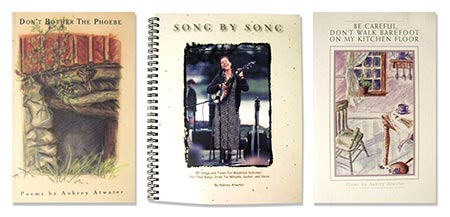
Aubrey is the author of 6 song, music, and poetry books. Did you know we carry her titles in the Craft Shop?
CP: If you were a dance move, what dance move would you be?
AA: The Wagon Wheel! This is a show step where I swing one leg behind the other like a wheel while chugging with the foot that is on the floor. It is very athletic but looks harder than it really is. The crowds go nuts over it. Elwood often exclaims to the audience, “And her foot never leaves her leg!” The Wagon Wheel is the epitome of the unbridled and unselfconscious joy that I feel when I dance. And the humor. It’s a funny step. Sometimes I do one leg, then the other. Then tell the audience, “I can do both legs at once, too. I just don’t feel like it right now.” Also, in terms of gender and dancing, I am among the first generations of women to do a step like this. Historically, women didn’t do an outlandish step like that. It wasn’t considered feminine or demure. Having been born in 1963, I am deeply aware of the great “cusp” I entered this world on–the unusually empowered times, family culture, and education I had as a girl. I think nothing of doing flamboyant steps that, historically, only men did.
CP: What are your favorite clogging shoes? Do you have any recommendations?
AA: I mostly wear Bloch solid tap shoes. I recommend starting with old-fashioned leather-soled shoes which is what I wore for years before switching over to taps. As the teacher, I like to be the loudest in my classes but I do tell students to get taps, too, for their own enjoyment and for when they get more advanced. It’s hard to find leather-soled shoes any more. You can order them on the internet, or I sometimes scout around thrift stores…
CP: For folks who are adults and have never played an instrument and want to learn one, what advice do you have for them to get started? Do you have any advice for aspiring old time musicians in general?
AA: We are all full of gifts, some of which may go untapped or undiscovered in our lives. One of the most surprising things that ever happened to me is that I became a dancer, mostly in my 40’s. I started dancing when many dancers retire. I don’t believe that you have to start learning music or dance when you are young. I have taught many older adults who never took music or dance lessons and I marvel at how much music and dance is within us all. I think one challenge is psychological. I often ask students, “What do you need to do for yourself to clear the path and get out of your own way, to be happily and unselfconsciously creative?” In our culture, many older adults have heard messages about how they can’t sing or play or that they are not good. Things they were told, perhaps, as children like in school chorus, “don’t sing, just move your lips.” (Yikes! I kid you not!) I ask adult students to recognize old those messages that might be holding them back and to shoo them away. Who has time for THAT? There is singing, playing, and dancing to be done! I love to watch people find their gifts and tap into all that they already know and intuit, having listened to music all of their lives.
(Below – Aubrey Atwater plays Old Joe Clark on the porch of the music studio at John C Campbell Folk School in Sept. 2009. Video by Gina Garland.)
CP: Do you have a favorite era/time period?
AA: Maybe late 19th century into the first part of the 20th century, when my great-grandparents, grand-parents and my dad were alive. My dad died last year at almost 92 and I treasured his stories about fishing, sailing, World War II. I like thinking about times before technology deeply changed aspects of our society and our psyches: the long anticipation of a letter; the marvel of a phone call; the relish of a visit from a relative who knows a lot of songs.
CP: What’s is like living in Rhode Island and playing traditional folk music? What are the differences between playing banjo/clogging in the Northeast v. the South?
AA: Rhode Island has a vibrant, action-packed scene of musicians, dancers, actors, artists, writers, chefs, you name it. It is an exciting state chock full of creative, innovative characters. There is a thriving old time music and contra dance scene here and well as a very strong Celtic and singer-songwriter scene. What Elwood and I do is fairly unique, however, because so much of our specialty is Appalachian music and dance. People sometimes do a double take and say, “Huh? How did you get into that?” It’s a long story but has something to do with my interest in Appalachia from a young age. Historically, my ancestors owned coal mines in West Virginia that supplied coal to the mills in our area.
So, having said all that, we have many fans and supporters here in RI/Southern New England as well as the South. I think one difference between audiences is that for some up here, we are showing them this music and dance for the first time and for some in the South, they already know it, get it, remember it from their own family cultures. What else is funny to observe are some of the subtle or not-so subtle differences in audience behavior/culture in different regions. New Englanders tend to be rather reserved and if you didn’t know better, you might think they didn’t like the concert (then they buy 50 CDs haha). Audiences in, say, the South or Midwest are often more demonstrative, effusive. I like that I come from New England because I am comfortable with the reserve and yet, forever delighted with the sometimes more dynamic responses of audiences in other regions.
CP: What’s your favorite Folk School memory?
AA: Two things spring to mind: last September I traveled like a maniac from Rhode Island to make my one-hour concert in time. I arrived from the Atlanta airport in a flurry, set up, had dinner, and this beautiful crowd wandered into Keith House. I did what felt like a perfect one-hour concert, with a thrilling exchange of energy, joy, humor with the audience. I would have traveled the earth for that one hour.
Another type of memory is the beautiful early morning at the Folk School, when I often wake up feeling rested and go for a quiet hike up behind the blacksmith shop and mill house. These are the kinds of things I treasure about the Folk School-the gift of beauty that stays with me long after I leave. When I am at the Folk School, I am overtaken by a quiet, loving, peace. The energy is one of thoughtfulness and nurturing, and I have learned a lot from that in my adult life, taking that away to other places like some kind of ambassador. I thank the spirit of the Folk School for that.
CP: Do you have a favorite place on the Folk School campus?
AA: Several! The path that leads down to the blacksmith shops. That view and scene is breathtaking! The the hike behind the blacksmith shop/mill house.
CP: Who your favorite superhero?
AA: Wonder Woman!
CP: What happens if you bother the Phoebe?
AA: This is SO my favorite question and I have thought about it for days. My second book of poetry is called Don’t Bother the Phoebe. Each section of the book starts with a poem about this unassuming, humble, somewhat drably colored little flycatcher who nested by our barn for many years and who, like all living creatures, has various trials and tribulations. The phoebe is my special bird. At home and in my travels to many places, I often see and hear her. The phoebe represents resilience for me. The metaphor of “not bothering” the phoebe has to do with leaving well enough alone and asking ourselves the questions: how do we stay connected, attuned, involved and yet also let go, trust in nature and ourselves, not overthink, step out of our own ways, ride the wave? All that is to say: our resilience and working hard at that balance as a daily practice is a deeply important aspect of our creative lives.
Aubrey is a performer and workshop leader who teaches with clarity, humor, patience, and a deep understanding of traditional music and dance. She has appeared in over 35 states and abroad, singing, clogging, and playing the mountain dulcimer, old-time banjo, guitar, tinwhistle, and mandolin. She is well known in the folk music circuit and as a dancer, thrilling audiences with her highly percussive clogging. Aubrey has 12 CDs and 6 books to her credit. Visit Aubrey’s website.




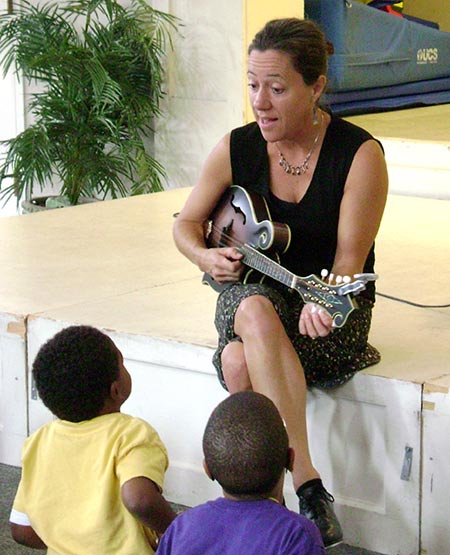
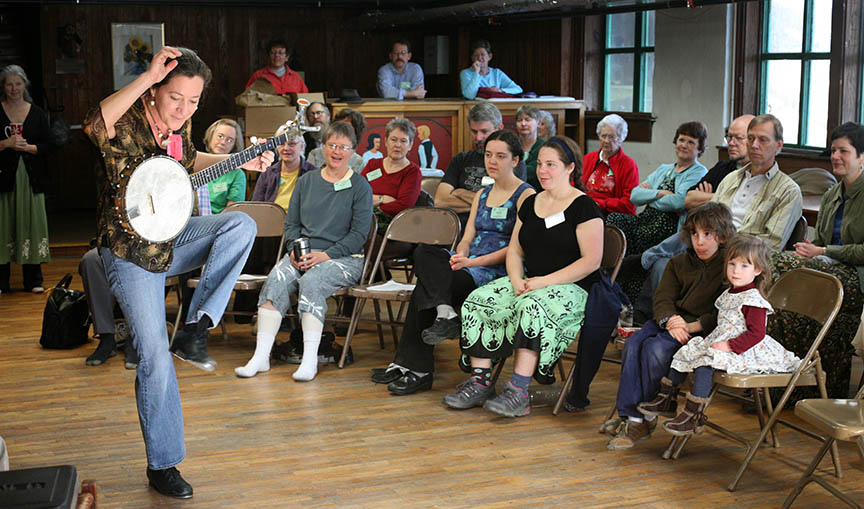
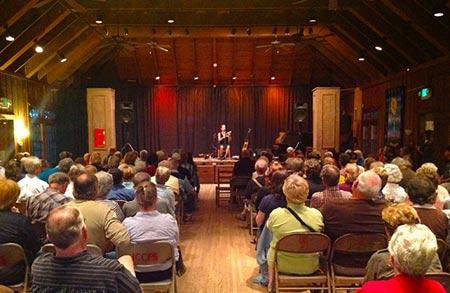
No Comments